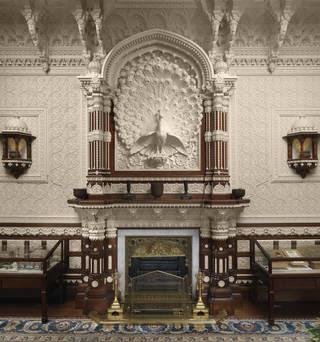
Don't judge me.
I would have definitely thought of this...
Mmmm, cake...
But shamefully I would not have thought of John Lockwood Kipling, father of Rudyard, husband of one of the Macdonald sisters and artist, writer, designer and Anglo-Indian Arts and Craft guru. Mercifully, to save me from my cake obsession, there is a new exhibition and almighty monograph on our chap to enlighten and delight. First, the exhibition...
I couldn't believe it was free, which is a rubbish way to start a review but it's true. In these days of nothing being free, to be given the chance to see such wonderful treasures in a proper exhibition and not having to pay a penny for the privilege feels a bit unreal. I kept waiting for someone to ask to see my ticket. But then I suppose it might have seemed a difficult sell - a lesser known Victorian (albeit with a famous name) who spent most of his creative life in the Punjab. 'Colonial' isn't a word people react to positively. However, the beauty of it overwhelms you, draws you in, until you are forced to realize that its so enmeshed in our idea of Victorian England it's impossible to think of it as 'other'.

Bracelet shown at the Great Exhibition, 1851, made in Rajasthan, India
A reason why the V&A have the exhibition is because Kipling started his career as an architectural sculptor at the South Kensington Museum (now the V&A). He and his new bride, Alice Macdonald, went to India where he worked as a teacher, and curator in Mumbai and Lahore. Whilst there, he continued his own design work, resulting in the most beautiful pieces.
Drawing of a wood carver from a collection depicting craftsmen (1870)
There are wonderful links between the art and craft of India and the heart of English artistic life in Victorian England. The exhibition shows how the Kiplings and their family provided a bridge over which inspiration could flow from the distant Empire into the heart of London and how much these threads are impossible to unpick from what we understand as 'Victorian'.
The Durbar Hall at Osborne, Isle of Wight (1890)
I had my doubts about how the exhibition would work as so much of Kipling's work was of a scale and location that couldn't be shoved into a corner of South Kensington, but enough of it could be brought in, or was already owned, that it all feels like great riches. I now have an overwhelming urge to see the Durbar Hall at Osborne again, my favorite part of the house, like being inside a wedding cake.
Whilst there is no substitute for visiting the exhibition or the places Kipling was working, the massive book that accompanies the exhibition is a pretty good place to start. Much more than just a straight catalog (hence the quite hefty price tag, £40) this is a sumptuous monograph in celebration of a forgotten artist who brought home the beauty of India.

John Lockwood Kipling and Alice Kipling (1865) Carl Holt
The monograph weighs in at over 600 pages, 700 color illustrations and further black and white ones. It is truly a mighty book which almost defies a simple review. I can't think of anyone who would not find something of interest in here and it is magnificently presented. I found the section on Alice Kipling extremely interesting for obvious reasons; in it there is information on the Macdonald sisters and Alice's adventure in India. I didn't know that the couple's eldest child, Rudyard, was named after the place in Staffordshire where the couple first met and where Kipling was employed in the Potteries.
Woman (probably Sophie Halsey) in a gown possibly designed by Kipling (1880)
Having an interest in Julia Margaret Cameron (amongst others), the cultural influence of the colonies on those who moved between England and the Empire hooked me in. It was nothing new by Victorian times, but just more widespread and more commercial, the East India Company being the Establishment that employed so many, let alone anyone who went out for other reasons. One of the pleasures of looking through Kipling's designs is how he applied the art and craft of the Punjab to Victorian England. His enthusiasm for the craftsmen of the country, his appreciation of their skill, make him a colonial William Morris.
Jug for Frederic Macdonald (1863)
Reading the catalogue, it is definitely a tale of more than one man, as Kipling lived many lives. His work in the Potteries is beautiful and accomplished, his work in Lahore, appreciative and immersive. No matter how we now feel (as society) about the work of Rudyard Kipling, it is easy to see a simple appreciation of the Indian culture through the work of his father. Familiarity with our close connections with other countries has lessened our appreciation, it seems. This is a book that opens your eyes to exactly how much beauty in Britain we owe to India and how we once celebrated the skill and talent of that country.
'Riki-Tiki-Tavi' from The Jungle Book by Rudyard Kipling
from my own collection
The exhibition is on until 2nd April, more information here.
The catalog is available from the V&A shop here and is worth every penny.

